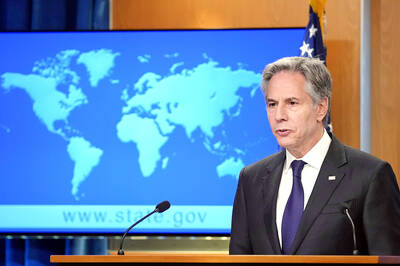The late Palestinian president Yasser Arafat's medical records do not give conclusive results regarding what caused his death, the New York Times and Haaretz newspapers reported yesterday, prompting Palestinian officials to call for the publication of the records.
The reports were the first based on the actual medical records since Arafat died in a Paris hospital on Nov. 11 after falling ill in his West Bank compound a month earlier. Arafat's widow and other relatives have kept the records secret.
A stroke was the final blow that killed Arafat, but it is not clear what disease or illness lead to a deterioration in his health, the Times concluded in its report. The records show, according to independent experts who studied them, that Arafat's symptoms make it highly unlikely that he died of AIDS or poisoning, the newspaper said.
But Palestinian doctors continue to insist that he was poisoned, the Times reported.
While the Israeli Haaretz daily cited experts as saying that Arafat died of AIDS, poisoning or an illness, it points out that the medical report states that "a discussion among a large number of medical experts ... shows that it is impossible to pinpoint a cause that will explain the combination of symptoms that led to the death of the patient."
Arafat's personal doctor, Ashraf al-Kurdi, who did not treat Arafat in his final weeks, said that he knows French doctors found the AIDS virus in Arafat's blood, Haaretz reported. The virus given to Arafat by Israel was used to disguise poisoning, he said, according to the daily.
A senior Palestinian official, Saeb Erekat, said he had not seen the records but had been told by many doctors that it was still not clear what had caused Arafat's death. Erekat said he had not heard any proof that Arafat had AIDS or had been poisoned.
Israeli Prime Minister Ariel Sharon's office called the accusations that Israel infected Arafat with AIDS or poisoned him "nonsense," Haaretz said.

‘IN A DIFFERENT PLACE’: The envoy first visited Shanghai, where he attended a Chinese basketball playoff match, and is to meet top officials in Beijing tomorrow US Secretary of State Antony Blinken yesterday arrived in China on his second visit in a year as the US ramps up pressure on its rival over its support for Russia while also seeking to manage tensions with Beijing. The US diplomat tomorrow is to meet China’s top brass in Beijing, where he is also expected to plead for restraint as Taiwan inaugurates president-elect William Lai (賴清德), and to raise US concerns on Chinese trade practices. However, Blinken is also seeking to stabilize ties, with tensions between the world’s two largest economies easing since his previous visit in June last year. At the

UNSETTLING IMAGES: The scene took place in front of TV crews covering the Trump trial, with a CNN anchor calling it an ‘emotional and unbelievably disturbing moment’ A man who doused himself in an accelerant and set himself on fire outside the courthouse where former US president Donald Trump is on trial has died, police said yesterday. The New York City Police Department (NYPD) said the man was declared dead by staff at an area hospital. The man was in Collect Pond Park at about 1:30pm on Friday when he took out pamphlets espousing conspiracy theories, tossed them around, then doused himself in an accelerant and set himself on fire, officials and witnesses said. A large number of police officers were nearby when it happened. Some officers and bystanders rushed

Beijing is continuing to commit genocide and crimes against humanity against Uyghurs and other Muslim minorities in its western Xinjiang province, U.S. Secretary of State Antony Blinken said in a report published on Monday, ahead of his planned visit to China this week. The State Department’s annual human rights report, which documents abuses recorded all over the world during the previous calendar year, repeated language from previous years on the treatment of Muslims in Xinjiang, but the publication raises the issue ahead of delicate talks, including on the war in Ukraine and global trade, between the top U.S. diplomat and Chinese

RIVER TRAGEDY: Local fishers and residents helped rescue people after the vessel capsized, while motorbike taxis evacuated some of the injured At least 58 people going to a funeral died after their overloaded river boat capsized in the Central African Republic’s (CAR) capital, Bangui, the head of civil protection said on Saturday. “We were able to extract 58 lifeless bodies,” Thomas Djimasse told Radio Guira. “We don’t know the total number of people who are underwater. According to witnesses and videos on social media, the wooden boat was carrying more than 300 people — some standing and others perched on wooden structures — when it sank on the Mpoko River on Friday. The vessel was heading to the funeral of a village chief in